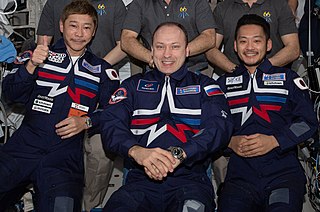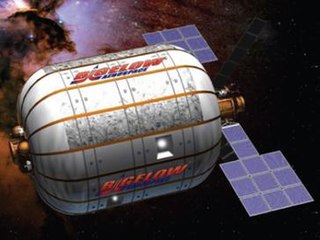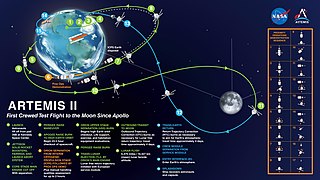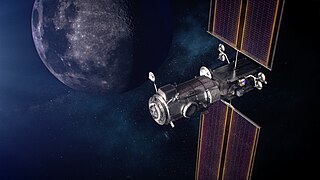Related Research Articles

The Space Shuttle program was the fourth human spaceflight program carried out by the U.S. National Aeronautics and Space Administration (NASA), which accomplished routine transportation for Earth-to-orbit crew and cargo from 1981 to 2011. Its official name, Space Transportation System (STS), was taken from a 1969 plan for a system of reusable spacecraft of which it was the only item funded for development. It flew 135 missions and carried 355 astronauts from 16 countries, many on multiple trips.

Space tourism is human space travel for recreational purposes. There are several different types of space tourism, including orbital, suborbital and lunar space tourism.

The Automated Transfer Vehicle, originally Ariane Transfer Vehicle or ATV, was an expendable cargo spacecraft developed by the European Space Agency (ESA), used for space cargo transport in 2008–2015. The ATV design was launched to orbit five times, exclusively by the Ariane 5 heavy-lift launch vehicle. It effectively was a larger European counterpart to the Russian Progress cargo spacecraft for carrying upmass to a single destination—the International Space Station (ISS)—but with three times the capacity.

The Constellation program was a crewed spaceflight program developed by NASA, the space agency of the United States, from 2005 to 2009. The major goals of the program were "completion of the International Space Station" and a "return to the Moon no later than 2020" with a crewed flight to the planet Mars as the ultimate goal. The program's logo reflected the three stages of the program: the Earth (ISS), the Moon, and finally Mars—while the Mars goal also found expression in the name given to the program's booster rockets: Ares. The technological aims of the program included the regaining of significant astronaut experience beyond low Earth orbit and the development of technologies necessary to enable sustained human presence on other planetary bodies.

Private spaceflight refers to spaceflight developments that are not conducted by a government agency, such as NASA or ESA.
Bigelow Aerospace is an American aeronautics and outer space technology company which manufactures and develops expandable space station modules. Bigelow Aerospace was founded by Robert Bigelow in 1998, and is based in North Las Vegas, Nevada. It is funded in large part by the profit Bigelow gained through his ownership of the hotel chain, Budget Suites of America.

The B330 was an inflatable space habitat privately developed by Bigelow Aerospace from 2010 until 2020. The design was evolved from NASA's TransHab habitat concept. B330 was to have 330 cubic meters (12,000 cu ft) of internal volume, hence its numeric designation.

The National Aeronautics and Space Administration is an independent agency of the U.S. federal government responsible for the civil space program, aeronautics research, and space research. Established in 1958, NASA succeeded the National Advisory Committee for Aeronautics (NACA) to give the U.S. space development effort a distinctly civilian orientation, emphasizing peaceful applications in space science. NASA has since led most American space exploration, including Project Mercury, Project Gemini, the 1968–1972 Apollo Moon landing missions, the Skylab space station, and the Space Shuttle. NASA currently supports the International Space Station and oversees the development of the Orion spacecraft and the Space Launch System for the crewed lunar Artemis program, the Commercial Crew spacecraft, and the planned Lunar Gateway space station.

The Boeing CST-100Starliner is a class of two partially reusable spacecraft designed to transport crew to the International Space Station (ISS) and other low-Earth-orbit destinations. It is manufactured by Boeing for its participation in NASA's Commercial Crew Program (CCP). The spacecraft consists of a reusable crew capsule and an expendable service module.
The Bigelow Next-Generation Commercial Space Station was a private orbital space station under conceptual development by Bigelow Aerospace in the 2000s and 2010s. Previous concepts of the space station had included multiple modules such as two B330 expandable spacecraft modules as well as a central docking node, propulsion, solar arrays, and attached crew capsules. However it was also suggested that each B330 can operate as an independent space station. Attaching a B330 to the International Space Station or flying a B330 alone have been suggested by Robert Bigelow.

Liberty was a 2011 launch vehicle concept proposed by Northrop Grumman Space Systems and Airbus Defence and Space for phase 2 of the NASA Commercial Crew Development (CCDev) program intended to stimulate development of privately operated crew vehicles to low Earth orbit.

A space tug is a type of spacecraft used to transfer spaceborne cargo from one orbit to another orbit with different energy characteristics. An example would be moving a spacecraft from a low Earth orbit (LEO) to a higher-energy orbit like a geostationary transfer orbit, a lunar transfer, or an escape trajectory.

Artemis 2 is the second scheduled mission of NASA's Artemis program and the first scheduled crewed mission of NASA's Orion spacecraft, currently planned to be launched by the Space Launch System (SLS) in November 2024. Four astronauts are to perform a flyby of the Moon and return to Earth, being the first crewed mission beyond low Earth orbit since Apollo 17 in 1972. The mission is also planned to be the first crewed launch from Launch Complex 39B of the Kennedy Space Center since STS-116 in 2006.

The Lunar Gateway, or simply Gateway, is the first planned extraterrestrial space station. It will be placed in lunar orbit and is intended to serve as a solar-powered communication hub, science laboratory, and short-term habitation module for government-agency astronauts, as well as a holding area for rovers and other robots. It is a multinational collaborative project involving four of the International Space Station partner agencies: NASA, European Space Agency (ESA), Japan Aerospace Exploration Agency (JAXA), and Canadian Space Agency (CSA). It is planned to be both the first space station beyond low Earth orbit and the first space station to orbit the Moon.
Axiom Space, Inc., also known as Axiom Space, is an American privately funded space infrastructure developer headquartered in Houston, Texas.

The Artemis program is a robotic and human Moon exploration program led by the United States' National Aeronautics and Space Administration (NASA) along with six major partner agencies— the European Space Agency (ESA), the German Aerospace Center (DLR), the Japan Aerospace Exploration Agency (JAXA), the Canadian Space Agency (CSA), the Israel Space Agency (ISA), and the Italian Space Agency (ASI). The Artemis program is intended to reestablish a human presence on the Moon for the first time since the Apollo 17 mission in 1972. The main parts of the program are the Space Launch System (SLS), the Orion spacecraft, the Lunar Gateway space station, and the commercial Human Landing Systems. The program's long-term goal is to establish a permanent base on the Moon to facilitate the feasibility of human missions to Mars.

Axiom Orbital Segment or Axiom Segment are the planned modular components of the International Space Station (ISS) designed by Axiom Space for commercial space activities. Axiom Space gained initial NASA approval for the venture in January 2020. Axiom Space was later awarded the contract by NASA on February 28, 2020. This orbital station will be separated from the ISS to become a modular space station, Axiom Station, after the ISS is decommissioned.
The Voyager Space Station or Voyager Station is a proposed rotating wheel space station, planned to start construction in 2026. The space station aims to be the first commercial space hotel.
Orbital Reef is a planned low Earth orbit (LEO) space station designed by Blue Origin and Sierra Nevada Corporation's Sierra Space for commercial space activities and space tourism uses. Blue Origin has referred to it as a "mixed-use business park". The companies released preliminary plans on 25 October 2021. The station is being designed to support 10 persons in 830 m3 of volume. The station is expected to be operational by 2027.
References
- 1 2 3 4 5 6 Luxury Space Hotel to Launch in 2021 Mike Wall, Space.com 6 April 2018
- 1 2 3 4 First luxury hotel in space announced Maureen O'Hare, CNN News 5 April 2018
- 1 2 Startup announces plans for low-cost commercial space station Jeff Foust, SpaceNews 5 April 2018
- ↑ "Orion Span Aurora Station". Internet Archive. Archived from the original on 14 March 2021.
- ↑ "Orion Span". Orion Span. Archived from the original on 13 June 2021. Retrieved 1 April 2021.
- ↑ This luxury space hotel could be up and running in four years NBC News 5 April 2018

